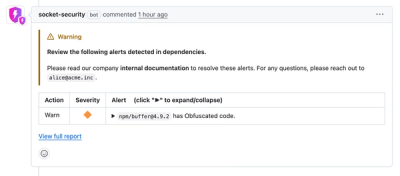
Security News
Crates.io Users Targeted by Phishing Emails
The Rust Security Response WG is warning of phishing emails from rustfoundation.dev targeting crates.io users.
qrious-core
Advanced tools
.d88888b. 8888888b. d8b .d8888b.
d88P" "Y88b 888 Y88b Y8P d88P Y88b
888 888 888 888 888 888
888 888 888 d88P 888 .d88b. 888 888 .d8888b 888 .d88b. 888d888 .d88b.
888 888 8888888P" 888 d88""88b 888 888 88K 888 d88""88b 888P" d8P Y8b
888 Y8b 888 888 T88b 888 888 888 888 888 "Y8888b. 888 888 888 888 888 88888888
Y88b.Y8b88P 888 T88b 888 Y88..88P Y88b 888 X88 Y88b d88P Y88..88P 888 Y8b.
"Y888888" 888 T88b 888 "Y88P" "Y88888 88888P' "Y8888P" "Y88P" 888 "Y8888
Y8b
QRious Core is the core engine for QRious' QR code generation as well as modules to support other environments (e.g. QRious Node).
Install using npm:
$ npm install --save qrious-core
You will most likely never need to depend on qrious-core directly. Instead, you will probably want to install a module
that supports your desired environment. For example:
As this is the core of QRious, it contains all of the QR code generation logic and, since it's designed to use HTML5
canvas to render the QR code, all that consumers need to do is define and register an implementation of
ElementService.
Most modules that use QRious Core will look something like the following:
var ElementService = require('qrious-core/src/service/element/ElementService');
var QRious = require('qrious-core');
var ExampleElementService = ElementService.extend({
createCanvas: function() { /* ... */ },
createImage: function() { /* ... */ },
isCanvas: function(element) { /* ... */ },
isImage: function(element) { /* ... */ }
});
QRious.use(new ExampleElementService());
module.exports = QRious;
This allows the core to control the primary API and keep it consistent across all environments. With the above in place, you are free to import QRious and use it as you would anywhere else.
You will find the primary API documentation on QRious. All direct consumers of core should also reference this to help developers find the information easily. However, they are encouraged to provide environment-specific examples.
If you have any problems with QRious Core or would like to see changes currently in development you can do so here.
If you want to contribute, you're a legend! Information on how you can do so can be found in CONTRIBUTING.md. We want your suggestions and pull requests!
A list of QRious Core contributors can be found in AUTHORS.md.
Copyright © 2017 Alasdair Mercer
Copyright © 2010 Tom Zerucha
See LICENSE.md for more information on our GPLv3 license.
FAQs
QRious core engine for QR code generation
We found that qrious-core demonstrated a not healthy version release cadence and project activity because the last version was released a year ago. It has 1 open source maintainer collaborating on the project.
Did you know?

Socket for GitHub automatically highlights issues in each pull request and monitors the health of all your open source dependencies. Discover the contents of your packages and block harmful activity before you install or update your dependencies.

Security News
The Rust Security Response WG is warning of phishing emails from rustfoundation.dev targeting crates.io users.

Product
Socket now lets you customize pull request alert headers, helping security teams share clear guidance right in PRs to speed reviews and reduce back-and-forth.

Product
Socket's Rust support is moving to Beta: all users can scan Cargo projects and generate SBOMs, including Cargo.toml-only crates, with Rust-aware supply chain checks.